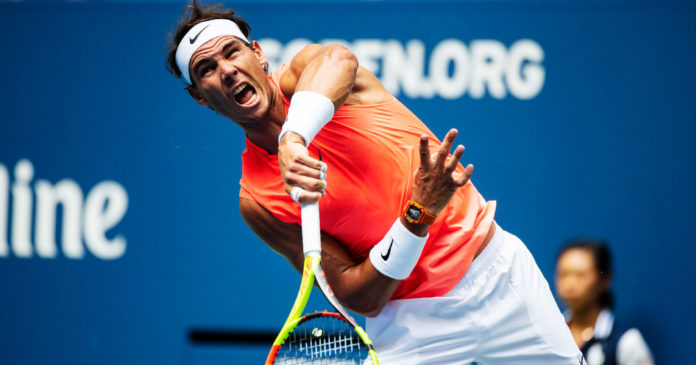Rafael Nadal not only has remained No. 1 this summer, still hungry for more at 32, he also has remained a classic-match magnet.
He was part of the two best men’s matches at Wimbledon: defeating Juan Martín del Potro in five sets in the quarterfinals and then losing to Novak Djokovic in five sets over two days in the semifinals.
He was part of the most irresistible match so far of this United States Open: holding off the next generation and Dominic Thiem in a grit-and-rip quarterfinal in which the full-stretch shotmaking often boggled the minds of those who managed to stay awake until it finished at 2:03 a.m. Wednesday.
Now, after not quite two full days of rest, the chances of another epic are good as he and the third-seeded del Potro prepare to lock forehands in their latest big-stakes duel on Friday.
This will be a semifinal, a round that has had gravitational pull for them in New York. Their only two previous meetings at the Open also came at this stage, with del Potro winning, 6-2, 6-2, 6-2, in 2009 on his way to his first and only major singles title.
Last year, Nadal won, 4-6, 6-0, 6-3, 6-2, on his way to a third Open title.
Neither of those duels lived up to expectations. Nor did this year’s French Open semifinal in which Nadal surrendered only seven games on his beloved red clay.
But they have created much more drama together elsewhere, with all five of del Potro’s career victories over Nadal coming on hardcourts.
Their Olympic semifinal in 2016 in Rio de Janeiro was exceptional, with del Potro prevailing in a third-set tiebreaker. Their Wimbledon match was the long-form version, with the level of play peaking in the fifth set, which Nadal won, 6-4.
“One of the best sets I have ever seen,” said Andy Murray, the former No. 1 and three-time major champion who was doing commentary for the BBC.
What to expect this time?
“Nadal always makes you run a little more, hit one more ball,” del Potro said. “And he ends up winning matches against you that you might not think he would end up winning. He knows my weak point. I can only imagine that this is going to be a super-difficult match. But if I can recover physically, and I’m feeling good, I will have my chances.”
In theory, Del Potro should be fresher. He has dropped only one set in the first five rounds, and that was against John Isner in a quarterfinal match that was played in steamy conditions but in which the rallies were rarely extended.
Del Potro has played for a total of 12 hours 16 minutes in Flushing Meadows this year. Nadal has played for a total of 15: 54, requiring 4:23 to defeat Karen Khachanov in the third round and 4:49 to fend off Thiem.
But Nadal has proved through the years to be almost as good at recovery as he is at whipping forehand passing shots on the run. And just like del Potro, he has had an extra day to recover, a luxury that Friday’s other semifinalists — Djokovic and Kei Nishikori — do not have at the business end of a particularly grueling tournament.
It also helps that this is only Nadal’s second tournament since Wimbledon. After winning the Masters 1000 event in Canada, he sagely chose to skip the Masters 1000 in Cincinnati, just as he wisely chose to skip grass-court tuneup events before Wimbledon.
In his youth, Nadal believed he needed a high volume of matches to be at his peak, but his new lead coach, Carlos Moyá, has reinforced the point that less can lead to more. Nadal has hit millions of strokes at full intensity in his 32 years, in practice and in competition.
What he needs now is to focus his efforts, conserve his energy and stay healthy, particularly after his halting start to the season. Concern about a knee injury led him to withdraw from the tournament in Brisbane, Australia, and a new hip injury forced him to retire, hobbling badly, in the quarterfinals of the Australian Open against Marin Cilic. He later skipped the Masters 1000 events in Indian Wells, Calif., and in Miami.
This is only Nadal’s ninth tournament of the year, not including Davis Cup. It is the 13th for del Potro, all of which means that he may not be all that much fresher on Friday afternoon.
Del Potro also has to deal with a hardcourt that Open officials intentionally made slower, which will make it harder to hit his thunderous forehand past Nadal.
But del Potro is certainly in imposing form. He has had significantly more winners than unforced errors in all his matches and is putting in an average of 70 percent of his first serves in play, a big number for someone who serves with his power and the best number of any of the semifinalists.
He also has been highly effective at net and continued to hit through his backhand, which has been his weak point since the series of wrist operations that nearly derailed his career.
In global terms, the most significant men’s story line available at this stage would be a victory by Nishikori, who would become the first Japanese man — and Asian man — to win a Grand Slam singles title.
Given Nishikori’s record against Djokovic, who has beaten him 13 straight times, that does not seem likely, although he did push Djokovic to four sets in the quarterfinals of Wimbledon this year.
But the most universally popular outcome would surely be a second major victory for del Potro, nine years after he secured his first by upsetting Roger Federer at Arthur Ashe Stadium.
Del Potro has paid his dues, repeatedly, and proved his class. Since the advent of the ATP rankings in 1973, he has more victories over reigning No. 1 players (nine) than any man who has yet to reach No. 1.
But even if del Potro manages it a 10th time and defeats Nadal, the chances are good that Djokovic will be waiting on Sunday and that the chances of another epic will remain very good.
Source : NYtimes













